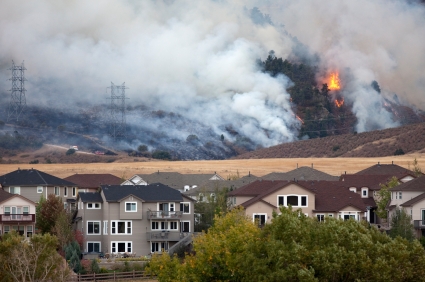 On the 10-year anniversary of the devastating Hayman Fire, and as forest fire season begins in the western states, two industry groups are reminding residents to prepare their families, home and businesses for a wildfire—both physically and financially.
On the 10-year anniversary of the devastating Hayman Fire, and as forest fire season begins in the western states, two industry groups are reminding residents to prepare their families, home and businesses for a wildfire—both physically and financially.
The Hayman Fire ignited southwest of Denver on June 8, 2002 and became the largest wildfire in the state’s history—burning nearly 140,000 acres, destroying 133 homes and forcing the evacuation of more than 5,000 residents.
The Property Casualty Insurers Association of America and the Rocky Mountain Insurance Information Association note that a dangerous wildfire season is forecasted for this year and major wildfires are already burning thousands of acres in Arizona, California, Colorado, Nevada, New Mexico and Utah. New Mexico is already battling its largest fire in history.
Ten years ago, Colorado homeowners insurance companies and fire officials learned valuable lessons from the month-long Hayman Fire. Insurers and fire officials now work together to inspect properties and make recommendations to homeowners to clear brush, clean out gutters and remove ignitable vegetation near structures in fire-prone areas to protect properties.
Insurers partner with state stakeholders to educate consumers on how to prepare and prevent damage from fires by distributing free Colorado and New Mexico Wildfire & Insurance Guides with homeowner disaster preparedness tips and how mitigation can impact their insurance.
“The Hayman Fire represented a significant turning point in the way fire risk was viewed in the Rocky Mountains,” Carole Walker, Executive Director of the Rocky Mountain Insurance Information Association, said in a statement. “Insurance companies consider wildfire risk a shared responsibility with homeowners and now commonly require property mitigation steps to get and keep affordable insurance if they live in a fire-prone area—a financial incentive lauded by fire officials to help reduce wildfires, as well as save lives and property.”
The National Interagency Fire Center in Boise, Idaho, forecasts an above normal significant wildfire season due to the mild winter and low precipitation. According to the NIFC, extreme drought conditions continue across the Southwest from western Texas to California and into the Great Basin.
Forecasters remain concerned about the western slopes of the Rockies in Colorado, parts of the Southeast including Georgia and Florida, Wisconsin, Minnesota and Hawaii. The NIFC reports that as of June 2012, 22,604 fires have burned 804,442 acres across the country. The Whitewater-Baldy Fire in New Mexico’s Gila National Forest has burned 404 square miles so far and it is only 15 percent contained.
“From east to west, we face a very real threat from wildfires this summer and there is no time like the present to take the steps necessary to protect your family, home and business,” Kelly Campbell, PCI vice president, said in a statement. “The most important thing to remember is take a home inventory, mitigate your property and regularly review your policy with your agent or company.”
Wildfire Preparedness Tips:
- Review Your Policy Regularly – Review your property insurance policy with your insurance company or agent. If you have recently remodeled or built a new addition onto your property, be sure to increase the amount of protection to cover the cost to repair or rebuild your home in today’s building costs. Consider policy endorsements to help cover building ordinance upgrades.
- Keep an Inventory − To speed claims processing, keep an inventory of your possessions and photograph or videotape them for documentation purposes. After a fire, list the items that were destroyed or damaged along with a brief description that includes receipts, appraisals, and the age, current value, make, model and serial number of items.
- Create Defensive Space − For those living in high fire hazard areas, the best protection is defensive space. Clear the land around dwellings of all vegetation. Experts recommend the cleared area extend 30 to 100 feet from the dwelling in all directions—depending on local ordinances or your individual property.












